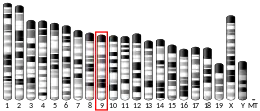P4HTM
Prolyl 4-hydroxylase, transmembrane is a protein that in humans is encoded by the P4HTM gene. [5]
| P4HTM | |||||||||||||||||||||||||||||||||||||||||||||||||||
|---|---|---|---|---|---|---|---|---|---|---|---|---|---|---|---|---|---|---|---|---|---|---|---|---|---|---|---|---|---|---|---|---|---|---|---|---|---|---|---|---|---|---|---|---|---|---|---|---|---|---|---|
| Identifiers | |||||||||||||||||||||||||||||||||||||||||||||||||||
| Aliases | P4HTM, EGLN4, HIFPH4, P4H-TM, PH-4, PH4, PHD4, prolyl 4-hydroxylase, transmembrane, HIDEA | ||||||||||||||||||||||||||||||||||||||||||||||||||
| External IDs | OMIM: 614584 MGI: 1921693 HomoloGene: 41765 GeneCards: P4HTM | ||||||||||||||||||||||||||||||||||||||||||||||||||
| |||||||||||||||||||||||||||||||||||||||||||||||||||
| |||||||||||||||||||||||||||||||||||||||||||||||||||
| |||||||||||||||||||||||||||||||||||||||||||||||||||
| |||||||||||||||||||||||||||||||||||||||||||||||||||
| Wikidata | |||||||||||||||||||||||||||||||||||||||||||||||||||
| |||||||||||||||||||||||||||||||||||||||||||||||||||
Function
The product of this gene belongs to the family of prolyl 4-hydroxylases. This protein is a prolyl hydroxylase that may be involved in the degradation of hypoxia-inducible transcription factors under normoxia. It plays a role in adaptation to hypoxia and may be related to cellular oxygen sensing. Alternatively spliced variants encoding different isoforms have been identified.
References
- GRCh38: Ensembl release 89: ENSG00000178467 - Ensembl, May 2017
- GRCm38: Ensembl release 89: ENSMUSG00000006675 - Ensembl, May 2017
- "Human PubMed Reference:". National Center for Biotechnology Information, U.S. National Library of Medicine.
- "Mouse PubMed Reference:". National Center for Biotechnology Information, U.S. National Library of Medicine.
- "Entrez Gene: Prolyl 4-hydroxylase, transmembrane". Retrieved 2017-10-03.
Further reading
- Oehme F, Ellinghaus P, Kolkhof P, Smith TJ, Ramakrishnan S, Hütter J, Schramm M, Flamme I (2002). "Overexpression of PH-4, a novel putative proline 4-hydroxylase, modulates activity of hypoxia-inducible transcription factors". Biochem. Biophys. Res. Commun. 296 (2): 343–9. doi:10.1016/s0006-291x(02)00862-8. PMID 12163023.
- Hirsilä M, Koivunen P, Günzler V, Kivirikko KI, Myllyharju J (2003). "Characterization of the human prolyl 4-hydroxylases that modify the hypoxia-inducible factor". J. Biol. Chem. 278 (33): 30772–80. doi:10.1074/jbc.M304982200. PMID 12788921.
- Pekkala M, Hieta R, Bergmann U, Kivirikko KI, Wierenga RK, Myllyharju J (2004). "The peptide-substrate-binding domain of collagen prolyl 4-hydroxylases is a tetratricopeptide repeat domain with functional aromatic residues". J. Biol. Chem. 279 (50): 52255–61. doi:10.1074/jbc.M410007200. PMID 15456751.
- Hirota K, Semenza GL (2005). "Regulation of hypoxia-inducible factor 1 by prolyl and asparaginyl hydroxylases". Biochem. Biophys. Res. Commun. 338 (1): 610–6. doi:10.1016/j.bbrc.2005.08.193. PMID 16154531.
- Iwahashi M, Muragaki Y, Ino K (2012). "Human prolyl hydroxylase expression in uterine leiomyoma during the menstrual cycle". Reprod. Biol. Endocrinol. 10: 111. doi:10.1186/1477-7827-10-111. PMC 3566935. PMID 23241241.
This article incorporates text from the United States National Library of Medicine, which is in the public domain.
This article is issued from Wikipedia. The text is licensed under Creative Commons - Attribution - Sharealike. Additional terms may apply for the media files.



